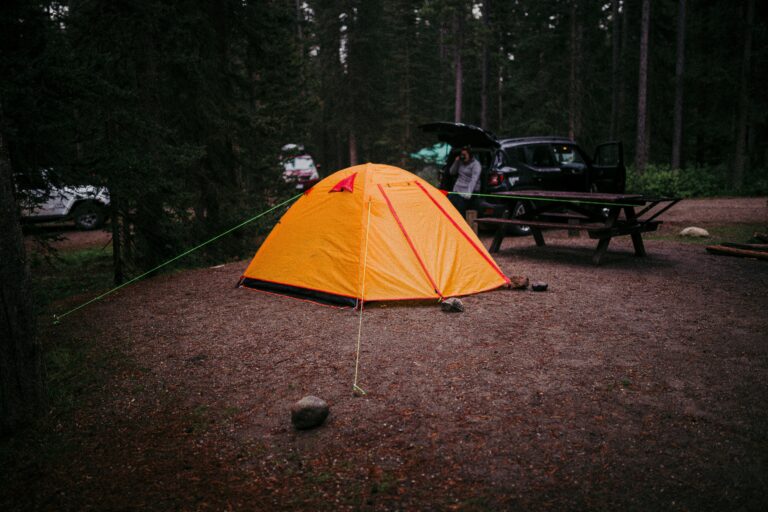The double-protection method smart campers swear by for UK weather
Key Points:
- Camping expert shares the most effective way to stay dry while camping during unpredictable spring rainy weather
- Expert explains why using both a rainfly and a ground tarp correctly is the key to staying dry, plus offers additional tips on proper setup and gear protection
- Expert highlights that with proper preparation, camping in the rain can actually create some of the most memorable outdoor experiences
As spring brings its characteristic mix of sunshine and showers across the UK, outdoor enthusiasts are preparing for their first camping trips of the season. However, the unpredictable weather can quickly turn an exciting adventure into a soggy nightmare if you’re not properly prepared.
“The number one complaint I hear from disappointed campers is waking up in a puddle,” says camping expert Andy Halliday from Lexrope, a UK-based company specialising in outdoor camping gear and accessories. “People often give up on camping altogether after one bad experience with rain, but there’s a simple solution that can make all the difference.”
Below, Halliday shares his top tip for staying dry while camping in the rain, drawing on years of experience helping families and solo adventurers enjoy the outdoors regardless of what the weather brings.
The Double Protection Method: Your Shield Against Rain
The most effective way to stay dry during wet weather camping isn’t complicated or expensive – it’s about using two basic pieces of equipment correctly: a rainfly and a ground tarp.
“This double protection method is what separates experienced campers from novices,” Halliday explains. “A properly installed rainfly combined with a correctly positioned ground tarp creates an almost impenetrable moisture barrier.”
A rainfly is the waterproof covering that goes over your tent, while a ground tarp (or footprint) is placed underneath. While many campers use one or the other, using both together creates a comprehensive system that keeps water from entering your tent from any direction.
How to Set Up Your Double Protection System
The key is in the setup. Campers frequently make the mistake of extending their ground tarp beyond the edges of their tent, which actually collects rainwater and channels it underneath.
“The ground tarp should be slightly smaller than your tent’s floor dimensions,” advises Halliday. “Tuck the edges under so they don’t extend past the tent. This prevents water from pooling between the tarp and tent floor.”
For the rainfly, ensure it’s tightly secured with all guy lines properly tensioned. This creates a slope that encourages water to run off rather than collecting on top.
“Give yourself extra time to set up in rainy conditions,” says Halliday. “Rushing often leads to mistakes that compromise your waterproofing. I recommend practising setting up your tent at home before your trip so you can do it quickly and correctly when you’re at your campsite.”
Additional Tips for Staying Dry While Camping
While the double protection method forms the foundation of staying dry, Halliday offers these additional tips to ensure a comfortable experience:
1. Choose Your Campsite Wisely
Location is everything when rain is in the forecast. “Always look for slightly elevated ground,” Halliday recommends. “Avoid setting up in depressions or at the bottom of hills where water naturally collects. Also, be wary of areas under trees – while they provide some shelter, water droplets will continue falling from leaves long after the rain has stopped.”
2. Create a Dry Zone
“Bring an extra tarp to create a sheltered outdoor living area,” says Halliday. “Hang it between trees at an angle, ensuring one side is higher than the other to allow water runoff. This gives you a dry space to cook, eat, and relax outside your tent.”
3. Pack Smart
Waterproofing isn’t just about your tent. “Store everything in waterproof bags or containers inside your backpack,” Halliday advises. “Bring extra clothes in sealed bags, and always have a dedicated set of dry clothes solely for sleeping. Even if the rest of your gear gets wet, having dry sleeping clothes makes a huge difference to your comfort level.”
Andy Halliday, camping expert at Lexrope, commented:
“Campers tend to see rain as the enemy, but with the right preparation, camping in wet weather can actually be quite magical. There’s something peaceful about the sound of raindrops on your tent while you’re warm and dry inside. The air feels cleaner, the crowds are smaller, and wildlife is often more active.
“The secret is being prepared rather than being caught off guard. By using the double protection method of a properly installed rainfly and ground tarp, along with smart campsite selection and organisation, almost anyone can stay comfortable regardless of the weather. I’ve taken families with young children camping in fairly heavy downpours, and with the right setup, they’ve had wonderful experiences they still talk about years later.
“Remember that nature doesn’t operate according to our ideal schedules. Some of my most memorable camping experiences have been during light rain showers. Being able to adapt to changing conditions is part of the adventure, and having the right knowledge makes all the difference between a miserable experience and a story you’ll be eager to tell.”
